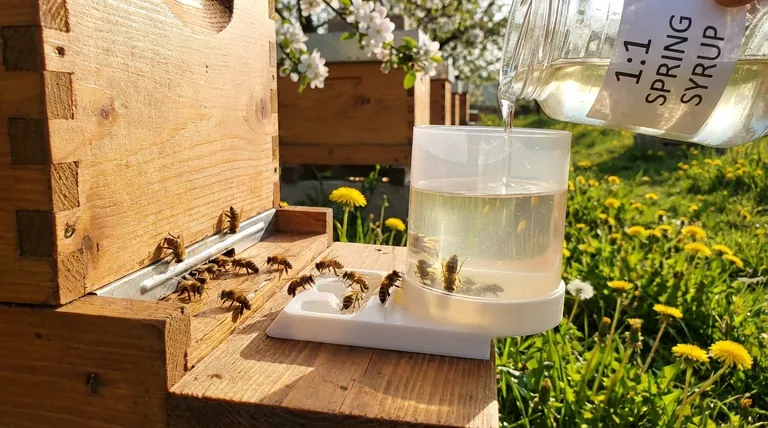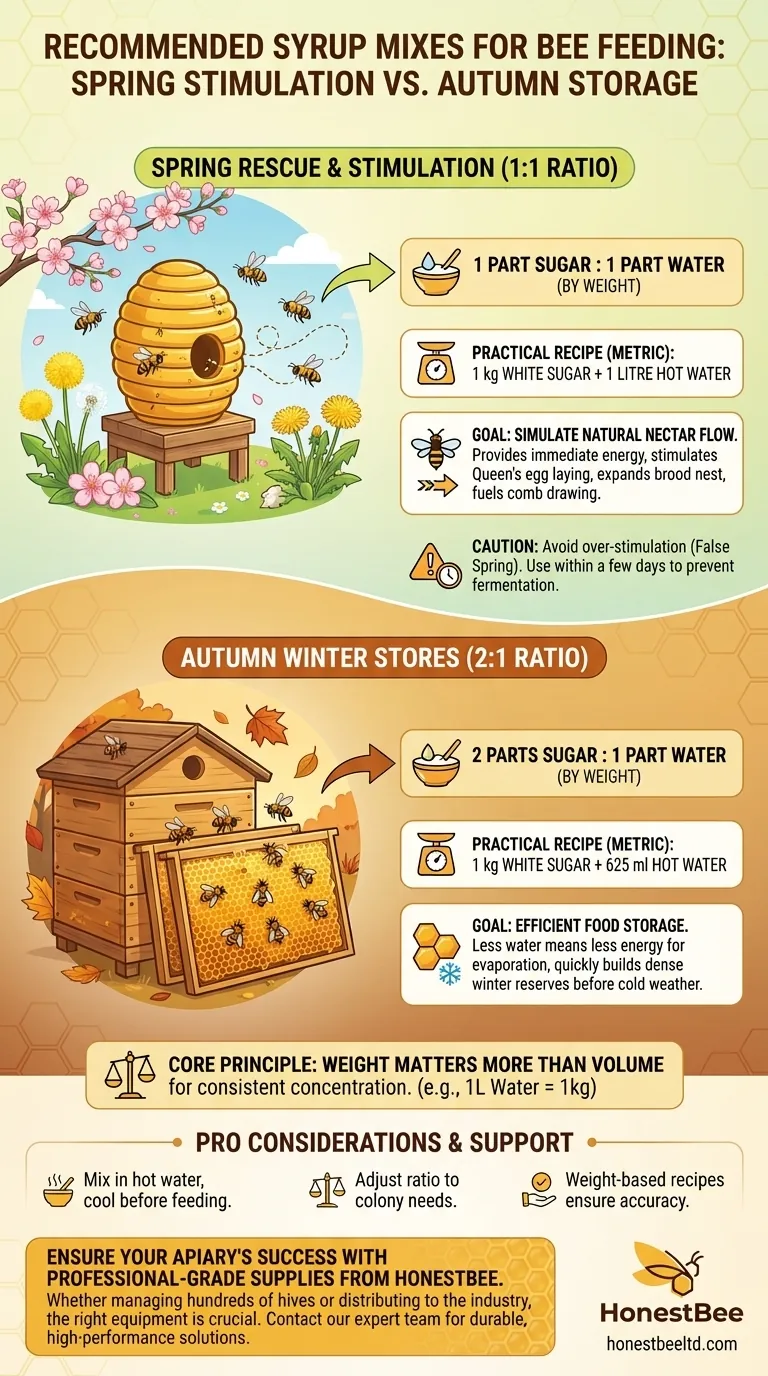For spring rescue feeding, the recommended mix is an intermediate or "light" syrup with a 1:1 ratio of sugar to water by weight. The most practical way to achieve this is by mixing 1 kilogram of white sugar into 1 litre of water, as 1 litre of water conveniently weighs 1 kilogram. This mixture simulates natural nectar, providing immediate energy and stimulating the colony's growth.
The core principle is simple: light, 1:1 syrup is for stimulation in the spring, while heavy, 2:1 syrup is for storage in the autumn. The ratio you choose directly signals a specific purpose to your bees, either mimicking a nectar flow to encourage growth or providing a dense food source to be stored for winter.

The "Why" Behind Syrup Ratios: Nectar vs. Winter Stores
The concentration of sugar syrup is a critical signal to the honeybee colony. By adjusting the ratio, you are mimicking different environmental conditions to achieve a specific outcome.
Simulating Spring Nectar Flow (1:1 Syrup)
A 1:1 syrup has a sugar concentration similar to that of natural nectar found during a spring nectar flow.
This "light" syrup acts as a stimulant. It encourages the queen to increase her rate of laying eggs and prompts the colony to expand the brood nest.
It also provides easily accessible carbohydrates, fueling high-energy activities like drawing new comb, raising young bees, and foraging.
Building Winter Reserves (2:1 Syrup)
A 2:1 syrup (2 parts sugar to 1 part water) is a "heavy" syrup designed for efficient food storage.
Because it contains much less water, the bees expend significantly less energy evaporating it down to the right consistency to be capped as honey stores.
This mix is used in the autumn to help the colony quickly build up the dense, heavy food reserves it will need to survive the winter.
A Practical Guide to Mixing Ratios
Always mix sugar into hot water to ensure it dissolves completely, but allow the syrup to cool to room temperature before feeding it to your bees.
The Standard Spring & Summer Mix (1:1 Ratio)
This is your multi-purpose syrup for the active season.
- The Ratio: 1 part sugar to 1 part water, by weight.
- Practical Recipe (Metric): 1 kilogram of white sugar dissolved in 1 litre of hot water.
- Practical Recipe (Imperial): 1 pound of white sugar dissolved in 1 pint of hot water.
- Primary Uses: Spring rescue feeding, stimulating brood rearing, emergency feeding during a nectar dearth (like the "June gap"), and fueling comb drawing for new colonies or nucleus hives.
The Autumn & Winter Mix (2:1 Ratio)
This syrup is used exclusively for building winter stores.
- The Ratio: 2 parts sugar to 1 part water, by weight.
- Practical Recipe (Metric): 1 kilogram of white sugar dissolved in 625 millilitres of hot water.
- Practical Recipe (Imperial): 2 pounds of white sugar dissolved in 1 pint of hot water.
- Primary Use: To be fed in the early autumn, ensuring it is complete by the end of September so bees have time to process and store it before cold weather arrives.
Understanding the Trade-offs
Feeding is a powerful tool, but improper use can create problems. Understanding the potential pitfalls is key to using it effectively.
The Risk of Over-Stimulation
Feeding a 1:1 syrup too early in the spring can create a "false spring" effect. This can encourage the queen to lay more eggs than the colony can support if the weather turns cold again.
This premature expansion can lead to the colony consuming their stores too quickly, increasing the risk of starvation.
Why Weight Matters More Than Volume
Professional beekeeping recipes are based on weight, not volume. A cup of granulated sugar weighs less than a cup of water.
Using weight (e.g., kilograms and litres, or pounds and pints) ensures you create a consistent and accurate syrup concentration every time.
Fermentation and Spoilage
Light, 1:1 syrup can ferment more quickly than heavy syrup, especially in warm weather.
Only provide an amount that the bees can consume within a few days to prevent the syrup from spoiling in the feeder.
Making the Right Choice for Your Goal
Select your syrup based on the specific need of your colony at that point in the season.
- If your primary focus is spring rescue or stimulating colony growth: Use a 1:1 syrup to mimic nectar and encourage brood rearing.
- If your primary focus is building winter food stores: Use a 2:1 syrup in the autumn for efficient conversion into capped honey.
- If your primary focus is drawing new comb or supporting a nucleus hive: Use a 1:1 syrup during the active season to provide the necessary energy.
Choosing the correct syrup ratio is a fundamental tool for managing your colony's health and productivity throughout the year.
Summary Table:
| Season | Syrup Ratio (Sugar:Water) | Primary Goal | Practical Recipe (Metric) |
|---|---|---|---|
| Spring / Summer | 1:1 by weight | Stimulate brood rearing & colony growth | 1 kg sugar + 1 litre hot water |
| Autumn | 2:1 by weight | Build winter food stores | 1 kg sugar + 625 ml hot water |
Ensure your apiary's success with professional-grade supplies from HONESTBEE.
Whether you're a commercial beekeeper managing hundreds of hives or a distributor supplying the industry, using the right equipment is as crucial as using the correct feed. HONESTBEE provides durable, high-performance beekeeping supplies and equipment through our wholesale-focused operations, helping you maximize colony health and honey production.
Ready to equip your operation for peak performance? Contact our expert team today to discuss your specific needs and discover how we can support your business growth.
Visual Guide

Related Products
- HONESTBEE Entrance Bee Feeder Professional Hive Nutrition Solution for Beekeeping
- Rapid Bee Feeder White Plastic 2L Round Top Feeder for 8 or 10-Frame Bee Hives
- HONESTBEE Round Hive Top Bee Feeder for Syrup
- Professional Hive Front Entrance Bee Feeder
- HONESTBEE Entrance Bee Feeder Efficient Hive Front Liquid Feeding Solution for Beekeeping
People Also Ask
- How is the mesh ladder and barrier installed in the feeder box? A Step-by-Step Guide to Prevent Bee Drowning
- What is an entrance feeder? A Guide to Its Simple Design and High Robbing Risk
- How do you make an entrance feeder for bees? A Guide to Safe & Effective Hive Feeding
- What are the common types of honey bee feeders? Choose the Right Feeder for Your Hive
- Are entrance feeders good for bees? Prioritize Hive Health Over Convenience



















